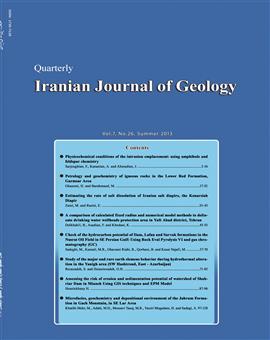Petrology and geochemistry of igneous rocks in Lower Red Formation, Garmsar Area
Subject Areas :
1 -
Keywords: Petrology, geochemistry extensional proto-back-arc basin Lower red Formation, Garmsar. ,
Abstract :
Numerous shallow depth basic intrusions crops out in the Lower Red Formation in Garmsar area. These intrusions have gabbro-dioritic compositions and granular, intergranular, ophitic and subophitic textures. Plagioclase, augitic clinopyroxene, amphibole and biotite are their main minerals and olivine, phlogopite, alkali feldspar, apatite, magnetite and sphene are their minor and accessory minerals. Their secondary minerals composed of serpentine, zeolite, chlorite, sericite, prehnite, sphene, uralite, quartz and calcite. These rocks plotted in gabbro-diorite realm in chemical classification diagrams. Geochemical trends of samples in major and trace elements variation diagrams versus differentiation index and in incompatible-incompatible and incompatible-compatible diagrams indicate the liquid line of descent and differentiation relations between samples. In the chondrite and primitive mantle normalized diagrams, enrichment in LREEs and LILEs, depletion in HREEs, absence of Eu anomaly, positive anomalies in K, Ba, Rb and Sr in all samples and strongly depletions in Nb and Ta in some samples and absence of depletion in Ti and P, are the characteristics features of these rocks. This indicates the crustal contamination of the mafic mantle magma formed these rocks. These rocks rather have the features of proto-back-arc basin (BAB) alkaline basaltic magmas, not the characteristics of the subduction related rocks. The dependence of these rocks to the back-arc basin basalts can be confirmed by different tectonic setting discrimination diagrams. It seems that the primary basic magma of these rocks has been generated from partial melting of an enriched mantle source under the continental lithosphere of Central Iran in an extensional proto-back-arc basin, during Late Oligocene time and intruded in lower part of Lower Red Formation.

